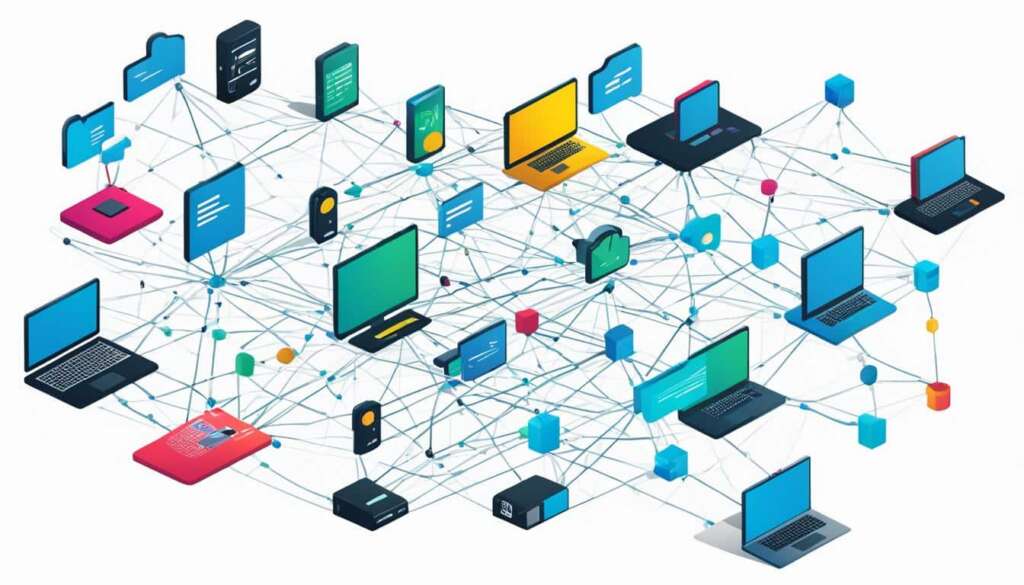Table of Contents
As mobile communications continue to evolve, the usage of efficient technologies to transmit data becomes more crucial. GPRS, or General Packet Radio Service, is one such technology that enables communication between mobile devices over a network. In this comprehensive guide, we will explore the details of this technology and its role in mobile communications.
GPRS is an essential technology that many of us rely on each day without realizing it. From sending text messages to browsing the web, GPRS enables the transmission of data over mobile networks. Understanding its workings is thus fundamental in comprehending mobile communications.
Key Takeaways
- GPRS stands for General Packet Radio Service
- GPRS enables packet-switching and efficient data transfer over mobile networks
- Understanding GPRS is fundamental in understanding modern mobile communications
- Mobile data transmission relies heavily on GPRS technology
- Efficient mobile data transfer over GPRS networks has revolutionized mobile communications
What is GPRS?
GPRS, which stands for General Packet Radio Service, is a mobile data transfer technology that allows for packet-switched data transmission over mobile networks. With GPRS, data is transmitted in packets rather than in a continuous stream, which helps to improve efficiency and reduce the cost of data transfers for both network operators and end-users alike.
One of the key advantages of using GPRS for mobile data communication is its ability to support a wide range of applications and services. From simple text messaging to more advanced services like multimedia messaging and mobile internet access, GPRS enables a broad set of mobile data transfer options that can be tailored to the specific needs of different users and applications.
At the heart of GPRS is the packet-switching technology that enables the efficient transfer of data over mobile networks. This technology breaks data into smaller packets that can be sent and received by different devices in a way that optimizes network efficiency and minimizes latency. By using GPRS, network operators can offer faster and more reliable data transfer speeds, while end-users can enjoy a more seamless and convenient mobile experience.
“GPRS enables a broad set of mobile data transfer options that can be tailored to the specific needs of different users and applications.”
Overall, GPRS has revolutionized mobile communications by enabling more efficient and cost-effective data transfer over mobile networks. Whether you are sending a simple text message or accessing the internet on your mobile device, GPRS provides a reliable and scalable technology that helps to keep you reliably connected to the world around you.
How Does GPRS Work?
General Packet Radio Service, commonly known as GPRS, is a technology used in mobile communication to transfer data over cellular networks. The data transfer process involves various elements that work together seamlessly to ensure smooth and efficient communication between devices.
GPRS uses packet-switching technology, which breaks down data into small, manageable packets and sends them over radio channels to the receiving device. These packets are transmitted over multiple radio channels, allowing for greater data transfer speeds and more efficient use of network resources.
The data transfer process in a GPRS network involves several steps. First, the device establishes a connection with the network. Once connected, it sends a request to transmit data, which is then broken down into packets and transmitted over multiple radio channels. The receiving device processes these packets and reassembles them into the original data for use.
The radio channels used in a GPRS network are dedicated to data transfer, ensuring that they do not interfere with voice communication channels. Additionally, GPRS networks have specialized equipment to manage and prioritize network traffic, ensuring that data is transmitted smoothly and efficiently.
Overall, GPRS is a reliable and efficient technology that enables fast and secure data transfer over mobile networks. By using packet-switching technology and specialized equipment to manage network traffic, GPRS facilitates efficient communication between devices, making it an essential component of modern mobile communication.
Conclusion
In conclusion, we have explored GPRS, a vital technology in the realm of mobile communications. We have discussed what GPRS is, how it functions, and its significance in enabling efficient data transfer over mobile networks.
GPRS has made mobile data communication fast and cost-effective, enabling users to browse the internet, check their emails, and send messages without any hassle. It is a crucial stepping stone towards modern mobile communication and has played a significant role in shaping the industry.
As the world becomes increasingly connected, the need for fast and reliable mobile data communication technologies like GPRS will continue to grow. With this comprehensive guide, you now have a solid understanding of GPRS and its role in the modern mobile landscape.
FAQ
What is GPRS?
GPRS stands for General Packet Radio Service. It is a technology that enables packet-switched data transfer over mobile networks. This means that instead of using a continuous connection like traditional circuit-switched networks, GPRS breaks data into small packets and sends them individually. This allows for more efficient use of network resources and enables faster data transfer on mobile devices.
How does GPRS work?
GPRS works by utilizing radio channels to transmit data. When a user sends or receives data on their mobile device, the data is broken into small packets and sent over the available radio channels. These packets are then reassembled at the receiving end to retrieve the original data. GPRS also involves various elements in its network architecture, such as GPRS support nodes and GPRS radio access networks, which play a role in facilitating the data transfer process.
What are the advantages of using GPRS for mobile data communication?
There are several advantages to using GPRS for mobile data communication. Firstly, GPRS enables faster data transfer compared to traditional circuit-switched networks. It also allows for the simultaneous use of voice and data services on mobile devices. GPRS is more cost-effective as it only charges for the amount of data transmitted, rather than the duration of the connection. Additionally, GPRS offers greater flexibility as it can be used with various mobile devices and across different network technologies.












